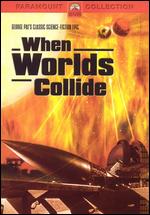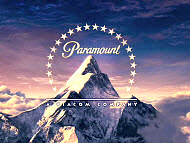When Worlds Collide
Reviewed by: Brett Willis
CONTRIBUTOR
| Moral Rating: | Better Than Average |
| Moviemaking Quality: |
|
| Primary Audience: | 10 to Adult |
| Genre: | Sci-Fi |
| Length: | 1 hr. 21 min. |
| Year of Release: | 1951 |
| USA Release: |

| Featuring |
|---|
| Richard Derr, Barbara Rush, Peter Hanson, Larry Keating, John Hoyt |
| Director |
|
Rudolph Maté |
| Producer |
| George Pal |
| Distributor |
This film, based on a 1932 novel, has influenced many subsequent Sci-fi flicks. The special effects won an Oscar although they look hokey by today’s standards.
A South African observatory calculates that a Jupiter-size star with an Earth-like planet is on a collision course with Earth. Central character Dave Randall (Richard Derr), a professional courier who chases women in his spare time (and sometimes even on the job), carries the documentation to the U.S. where the findings are confirmed by Dr. Cole Hendron (Larry Keating); Randall somehow gets pulled into Hendron’s survival project and also into a serious relationship with Hendron’s daughter Joyce (Barbara Rush, “Hombre”). Most astronomers discount the findings (the computers of the day—they’re called “differential analyzers”—are slow and clunky), and the public doesn’t believe Hendron until it’s too late. However, millionaire Sydney Stanton (John Hoyt) does believe him, and finances the construction of a spaceship that will carry 40 people and some plants and animals to the “new planet” before Earth is destroyed by the “new star.” Similar ships are supposedly being built in other countries. (After the impact that destroys Earth and the tiny star, the new planet will be captured by our Sun.)
There are many similarities to the 1998 film “Deep Impact”—a lottery to select those who’ll go to safety; some references to prayer; the “Noah’s Ark” terminology; a two-stage disaster, with hordes of people fleeing coastal areas and going to high ground in hopes of living just a little longer; some people being noble and self-sacrificing in the face of death while others become savage. One other similarity is the bad science; of course the film’s point isn’t science but human drama.
Content Warning Notes: There’s no profanity. The worst “sexual” content is the nonchalant Randall kissing with a girl while he’s supposed to be piloting his plane. (As the crisis approaches, Randall is transformed into one of the “noble” people.) There’s only one visible on-screen death. Although the Earth is devastated with quakes and floods and is later completely destroyed, the special-effects shots don’t show any dead bodies. The primary focus is on the way people interact in a crisis. I believe most children age 10 and up (younger, if they’re not the “worrying” type) could watch this without having nightmares; but that’s an individual parental decision.
Spiritual Content: The film actually opens with an on-screen quote from Genesis 6:12,13 about God sending Noah’s Flood as a judgment; we see that the Bible is the first of the many “important books” being taken on the spaceship; and at the end, a Biblical-sounding passage about the first day on the new planet is shown on-screen in the same calligraphic type font used earlier for Genesis. So the writers are making this fictional disaster into the antitypical counterpart of the Flood. That would mean either that we’d successfully thwarted God’s judgment (not likely), or else that God had always planned on some people escaping to the new planet. The Bible does say that the Earth will receive a “judgment of fire,” corresponding to the “judgment of water” in Noah’s day; however, the way to escape that judgment and to reach the “new heavens and new Earth” isn’t a spaceship, but a right relationship with God through Jesus Christ (see 2 Peter 3:3-18).


PLEASE share your observations and insights to be posted here.

